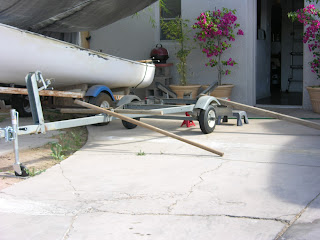The brass fitting that was riveted to the keel was loose and the rear 2" of the keel had been replaced with resin filler and glass cloth. When the brass fitting was removed and the glass removed from the keel, the wood around the fitting was pretty bad and the back of the keel was also pretty bad.
I trimmed the keel down, cut a piece from the Red Oak I have been using and epoxied the brass fitting and the Oak piece on to the keel eliminating any rivets or nut & bolts. I also left the 2" off the rear of the keel. Since I do not intend to race this boat and only intend to produce a family day sailor, I don't see that the 2" will make that big of a difference in performance. If I find that it will not perform, I will attempt to rebuild the rear of the keel at a later date, adding another 2 inches.
The keel is now ready to take 2 coats of resin, a layer of glass cloth and a final coat of resin and then paint.
Follow Up:
Well, It looks pretty good in the picture........ BUT..................I used a cheap ($2, 2") brush. Applied 2 coats straight off. I got way too much paint on and it would not dry. When I thought it was dry, I tried to sand it. That just roughed up the wet spots, took a load of grit from the sandpaper and deposited the same into the wet paint. I tried to let it dry again and repeated the process, this time with a good brush, with the same result. I spoke to a friend of mine, Mike Parker, who is a retired professional Auto & Boat painter. He told me I needed to use primer, thin out the paint with thinner and pay attention to the temperature as paint doesn't like it over 80 something degrees (Fahrenheit). All good advice. Thanks Mike for taking the time to listen to my amateur project! . But.....I really didn't want to use a primer for various reasons (cost, time to apply, ultimate desired results being lower than a pro's), I wasn't comfortable thinning the paint not knowing just how thin it should be, and I wake up to 90 degrees here in Phoenix, AZ so I had to figure out just how to get the same results I got on the hull at 110 degrees with the same paint.
So I bought some stripper at Home Depot (Citristrip) that I thought would strip the paint and leave the epoxy alone. It worked OK. I then sanded again with 150 grit. Looked good so far. Now the question was, how to apply (without a spray gun since I didn't have one or want to spend the $$$ to get one). I decided to use the 4" foam roller that I used on the hull. YES! It put on just the right amount of paint, 2 coats one right after the other. Let dry for a couple hours and one more coat. Drying and setting hard. Looks real good now.
By the Way: Truck License Plate MMELEVN = Martina McBride Eleven (her current Eleventh Studio CD)
I also cut a small ladle out of an aluminum V8 juice can and avoided the pool of paint in the lid well since I did not have to pour the paint out of the can but ladled it into the paint tray.

















